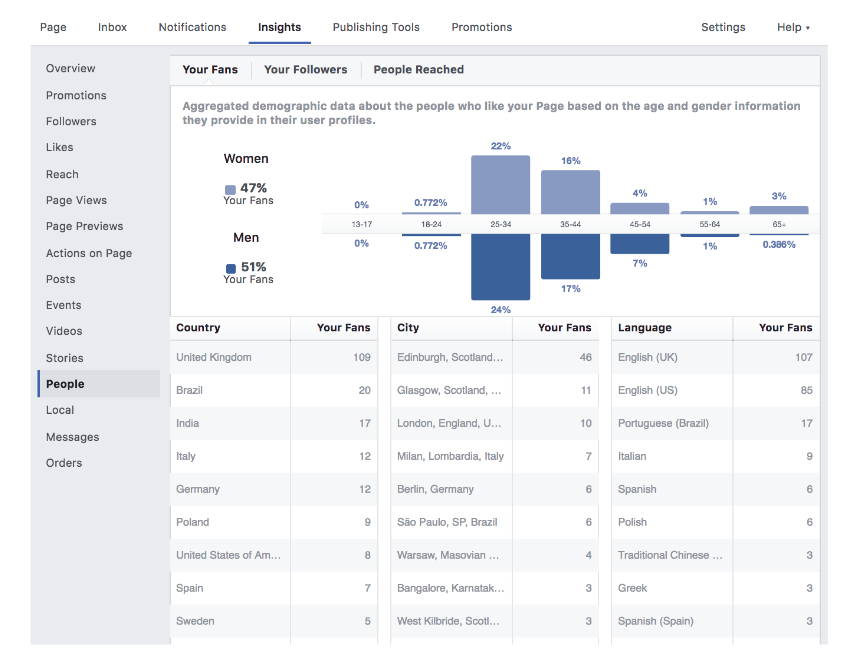Sometimes it might feel like playing the social media marketing game is like being back at high school. You know that place where you felt awkward, like you didn’t fit in, and you’re surrounded by intimidating, shiny, happy, shouty people? Well fear not. I’m here to tell you that it won’t last forever. You can get through it. Join me in figuring how with a solid marketing plan.
I’ve split the article into two parts, the first will focus on preparation and planning, the second will cover ways to understand and engage people online and showing your creativity.
Failing to prepare is preparing to fail
To make the most of social media marketing you need to do research, also known as creeping. Research allows you to start and join conversations with valuable contributions on topics you know are of interest to your target audience. Developing effective and time efficient auditing techniques to gather usable insight is the key to building your confidence in the social sphere. You might have been the anti-studying type in school but now is the time for change. Prepare to dazzle with wit and knowledge that you didn’t even know you had by sharing valuable insight with your online acquaintances. Sound good? Let’s get cracking. Here are some tips to get your research off to a flying start:
- Scope out the popular crowd
Start by listing your competitors (direct and indirect) then select your top 10 to audit. Take notes. Record who is posting, tweeting and sharing great blog posts. Are they nailing it, why or why not? What can you replicate or improve? Note which channels they are using or not using and how often. Read all their posts and website articles, take notes on style, tone and visual creative. Notice who they engage with most often and identify with which content. Here’s a sneaky one, find out who’s the most influential out of their follower list (for this I use a tool called followerwonk). It might feel cringey but no one needs to know, just you and your secret notebook (or excel doc – however you like to record notes).
- Figure out who you want to be friends with
Understanding your target customer is standard practice in the marketing world. In the social media world it’s the difference between ‘doing’ and ‘using’ social media and you can put what you think you know to the test in real time. The question is ‘how’? Well, firstly try to define your target audience groups, by defining demographics (age, location, gender, income, education, marital status, occupation), psychographics (personality, attitudes, values, behaviour) and interests (lifestyle, hobbies). Use sales information to get you started. Think about why your customers buy from you. Look for common characteristics and interests. Are there any commonalities with those who return and generate the most revenue? If you haven’t already, list out all the benefits of your products/services and next to it write someone who has a need for that benefit. Ie. If you sell cat collars – one benefit would be cat owners protecting their cat – and the audience who would benefit are cat owners who let their cat roam outside. Whilst this is quite general, it gives you a starting block to build-on, to define in more detail the challenges your customers face and that your product/service can alleviate. Like a loosing your cat.
The next step is to look at social media insights; starting with your business Facebook page (if you have one), there is an insights tab along the top navigation. In the insights section you will find ‘People’ down the left-hand-side menu, in there you will find demographic data (gender, age and location). You can marry this data up with the data in the ‘Posts’ section as it will give you an indication of interests.
You can find equally as useful user insights in Twitter Analytics (audience tab) and in LinkedIn Business page (manage page, analytics then visitors dropdown).
It would be wrong to move on without mentioning the magic of Google Analytics demographic data. Ok stay with me on this, it won’t take long. If you have Google Analytics setup then please continue to read on, if not skip to the next paragraph until you get it set up!
The demographics category in Google Analytics includes four dimensions (age, gender, ((affinity categories, In-market segments – don’t worry if these categories don’t make sense, they align with Adwords audience targeting)) this data is predicted by Google, based on the user’s browsing behaviour. Google Analytics also provides location information which can highlight suspicious looking traffic that will most likely be spam, and useful city data that can help you create localised content. Last but by no means least Google Analytics gives you behaviour data, this is by far one of the most valuable sections on the platform. Behaviour data includes: new vs returning, frequency vs recency and engagement. As an example, you can use this data to understand more about what engages your return visitors.
If you’re just starting out, try to do some market research or have a look at a direct competitor – what does their demographic look like? Try searching online for research on your target market. Search for articles and blogs that talk about or to your target market. Search for blogs and forums where people in your target market communicate their opinions. Look for survey results or build a picture and start to evolve as you get more insight when you start sharing, but where should you start sharing?
- Choose the right subjects
Now that you have a better understanding of who you want to attract, it’s time to seek them out online in the places they hangout. The best option is to choose a couple of those places and ensure your activity here is strong! Here are some tips to get you on the right road:
- Start by looking at the average demographic statistics for each social platform. If you haven’t already assessed all the features and functionality across your top social channels – will the functions allow you to share content and engage in the way that suits your business?
- Choose 5 – 10 ideal customers from your mailing list or social media and start-up a dialogue with the intention of asking them some questions on where they hangout online ie. which social media channel is your preference? You send out a survey monkey (you may need to incentivise to ensure you get responses).
- If you did a thorough job during your competitor research you’ll know which channels they are using, and these should guide and influence your choice. This is something that can be applied to any website of interest. If you’ve not heard of a tool called Buzzsumo, then check it out immediately. It’s fantastic for content research, influencer research (both topics will be covered later) and social channel insight. If you type the URL of a website into the search box it will give you a list of articles most shared and the corresponding social channels that were most used – sneaky!
- Study the course materials in depth
Now the fun begins. Time for a bit of content research, get your excel doc ready to record. There’s a wealth of content out there so take all the help you can get and find the right tools that work for your business needs. Search for articles that will give you lists of ‘new free content marketing tools’ so you keep up-to-date with your resources. For your content research you want to be looking at it from a customer point of view so look at metrics with high volume, engagement and shares. Here are some power tools to get you going:
- Start off by looking at Google’s Keyword Planner to give you insight on popular search queries for your key business priority areas. Google’s keyword planner can be overwhelming, but take your time and whittle down the terms that provide the sweet spot of volume and competition.
- Look at Buzzsumo -this platform will give you an incredible amount of content marketing insight, in particular it gives you articles with the most social shares and influential profiles (we’ll cover this in more detail in part 2).
- Try search on social channels like Twitter, Pinterest, Instagram to give you an idea of what’s out there, what people respond to and what inspires you. Search industry hashtags and keep a note of those with the highest number of posts attached.
- Hubspot is a goldmine of resources for content marketing guides and tactics to help you make the most out of your inbound marketing efforts.
- Feedly is a favourite content curation tool of mine, you can create categories and follow writers or publications within that field. It makes finding and sharing content really easy.
- When it comes to simple idea generation for content try Ubersuggest and Soovle.
Ok, study period is drawing to a close – it is time to plan how to get your social activity from good to great. At the start of every plan should be an objective. It’s the ‘why’ behind all this effort? Do I really need to pass Higher English to study English Literature at University? Well yes, yes you do.
By setting a goal you’re halfway there
For those of you trying to succeed at social media without an objective, strategy and plan, I salute you, because it’s a near impossible task. Before you put fingers on your keyboard or pen to paper, record the goal you want to achieve; remember it should reflect a version of your business objective. In simple terms, a social media strategy is just a series of actions that are going to help you achieve your goal, within an allotted time frame. An example goal might be to generate 15% more leads from social media traffic. The term ‘strategy’ might seem intimidating but building an effective social strategy doesn’t need to be difficult. The final section of this article is dedicated to creating the ultimate plan using all the insight from your audit and research phase to create a strategy to boost confidence on social media. Here’s all you need to know about social media planning:
- Grades
As mentioned above, start with a goal. It would be wise to think about a short-term (3 months) and a long-term (1 year) goal to keep up the momentum. Allocate numerical targets to your goals; make each one achievable, meaningful and measurable.
- Exam study plan
Now you know what you’re trying to achieve, write down how to make that dream a reality, that’s right – it’s a strategy and project plan. As soon as you write something down you are then held accountable and therefore are more likely to make things happen. Write down what are you going to achieve, how are you going to do it and when? Think about budget requirements to create the highest quality for your social media channels. Will you need to brief content writers? Will you need to brief illustrators, videographers or purchase stock images? Write down all your channels, allocate activity, ownership and deadlines. The activity should include a mixture of actions and social media text (including trackable links and description of images). Sounds easy right? Well, not really because creating a plan is not a one off job, you need to keep working on, evolving and refining the plan using performance metrics.
- Using online resources to your advantage
All that’s left is to let technology do all the heavy lifting by scheduling your social media posts in advance using tools like: Hootsuite, Sprout Social, Buffer or even Facebook scheduler. Each of these tools let you track hashtags and monitor your competitors, both worthwhile tactics for keeping in the know. One final suggestion is to ensure that the links (from your social media post to your blog article or elsewhere) are trackable in Google Analytics (if you have GA set-up). If this is all news to you, then you can create bespoke and trackable links by using a URL builder like Google’s Campaign URL Builder, just follow the instructions then shorten your URL using Bitly and all your social media traffic will arrive all packaged up in Google Analytics ready for you to marry up with your social media analytics.
This article has gone on long enough for now, so let’s round-up. Confidence is generally born from knowing your stuff, when it comes to social media confidence, knowing your stuff is: understanding your customers, keeping an eye on your competitors, selecting the right platforms and utilising the features, knowing your stuff, setting goals, creating a plan and sticking to it.
The next installation is when the fun really begins, we’ll discuss creative content, engaging in the dying art of conversation, building relationships and partnerships with influencers. Then taking 5 to decide if putting yourself out there on social has been worth it. Don’t leave me just yet – come back and finish the job.
Guest Blogger Kirsty Kirkhope.





